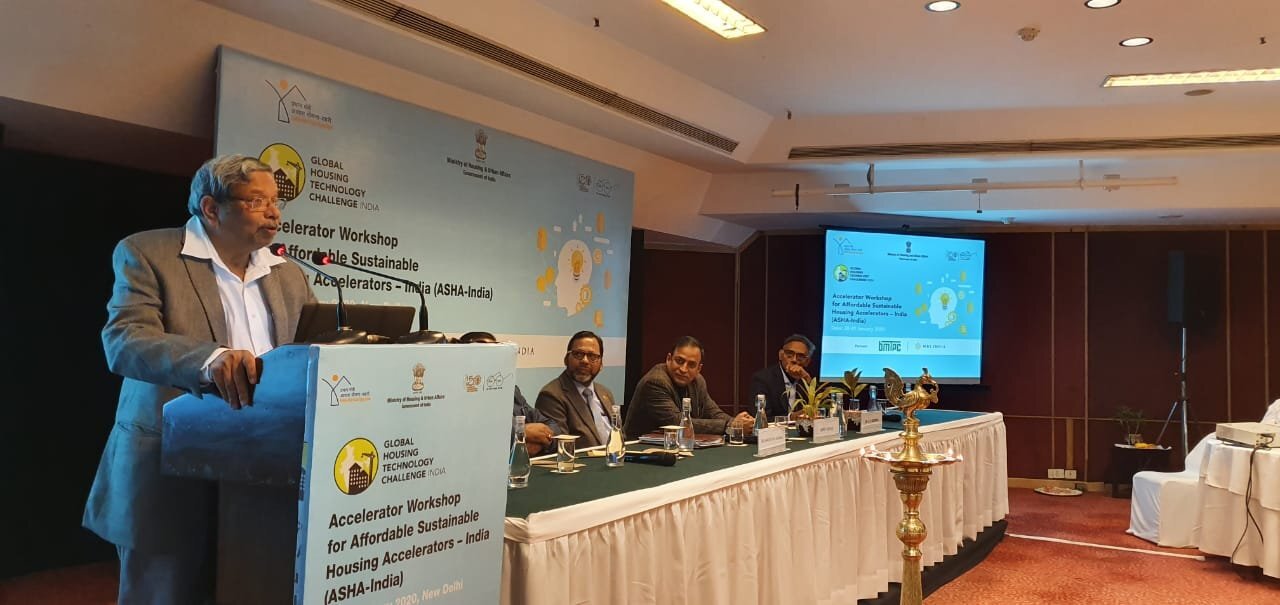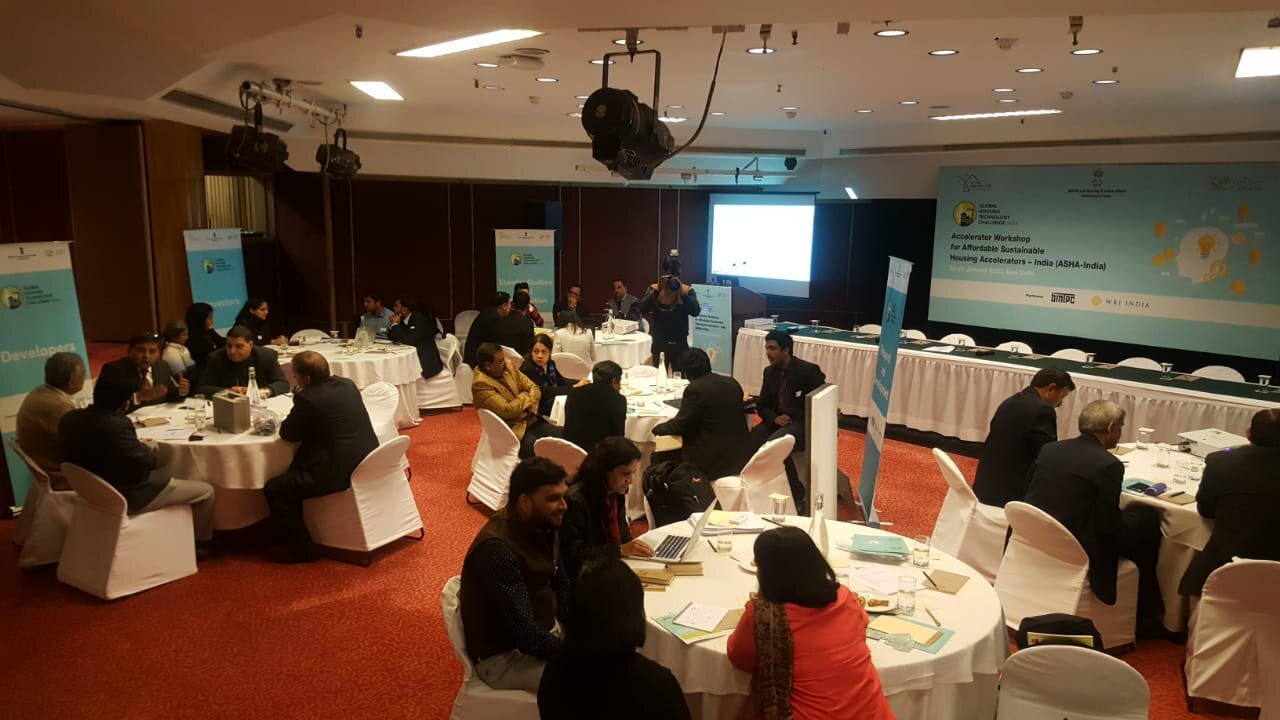Global Housing Technology Challenge - India
Decoding its significance for affordable housing in India
June 26, 2020
- By Pallavi Sharma
Guest Writer
(Pallavi Sharma, a sustainable development consultant, has worked with the National Institute of Urban Affairs, has been a researcher at IIT Delhi and won DAAD Scholarship to Germany during her Masters in Climate Science and Policy)
The Pradhan Mantri Awas Yojana – Urban (PMAY-U) set out an ambitious target of meeting the validated demand of nearly 11 million houses in urban areas by 2022. Realising the need to speed up the implementation of housing projects across the country to meet the “housing for all” vision, the Ministry of Housing and Urban Affairs (MoHUA), launched the Global Housing Technology Challenge – India (GHTC-India) on January 14, 2019, which leverages the Technology Sub-Mission (TSM) under PMAY-U.
GHTC-India has been conceptualised to boost the country’s capacity to deliver sustainable and quality housing in a quick and cost-effective manner. The concepts of skill, scale and speed (termed the “3-S mantra”) are being stressed upon through the GHTC-India, along with aspirations for eco-friendly, disaster resilient, innovative, low cost and sustainable technologies for mass housing.
The Building Materials and Technology Promotion Council (BMTPC), which is the nodal agency for the TSM, has been assigned as the technical partner of MoHUA in implementing GHTC-India. MoHUA has also partnered with the World Resources Institute (WRI), India and National Real Estate Development Council (NAREDCO) to serve as knowledge partners to collaborate, advise, support and facilitate conducting GHTC-India. In addition, the ministry has also roped in Associate Knowledge Partners (AKPs) of national and international repute including Indian Institute of Technology (IIT), National Institutes of Technology (NITs), National Institute of Urban Affairs (NIUA), Massachusetts Institute of Technology (MIT), Confederation of India Industries (CII), International Finance Corporation - World Bank Group, UN Habitat, Confederation of Real Estate Developers' Associations of India (CREDAI) etc. Further, Bloomberg Philanthropies is a strategic partner.
The challenge has been devised in three parts (Figure 1):
Conducting a grand expo-cum-conference (designated as Component 1);
Implementing light house projects (LHPs) in select cities (designated as Component 2); and
Setting up of affordable sustainable housing accelerators (ASHA) (designated as Component 3).
Figure 1: Schematic of the Global Housing Technology Challenge - India
Source: GHTC-India, MoHUA
Figure 2: Timeline of the Global Housing Technology Challenge - India (2019-2021)
Source: GHTC-India, MoHUA
Component 1: Expo-cum-conference
It has been over a year since Construction Technology India (CTI) 2019 was held during March 2-3, 2019 at Vigyan Bhawan, New Delhi (Figure 2). This was the first edition of the Expo component under GHTC-India. The exhibition, thematic sessions, panel discussions and master classes held during CTI 2019 were meant to promote innovative construction technologies by exposing local technology providers to global construction practices while showcasing a market in India for cutting-edge construction technologies. The event recorded a participation of about 2,500 delegates from 32 countries.
CTI-2019 also served as a platform to shortlist technologies for the other two components under GHTC-India, namely ASHAs and LHPs.
The Technical Evaluation Committee (TEC) evaluated 54 “proven” technology providers with 32 innovative technologies from 25 countries including the USA, Spain, France, South Korea and Italy, to shortlist technologies for LHPs. The proven technologies invited to exhibit at the Expo were selected through a global online competition for which applications were received up to February 28, 2019. The 54 eligible technology providers were eventually grouped under six broad technology categories in May 2019 (Table 2).
Meanwhile, to select candidates for the ASHA component, 78 “potential” technology providers presented 55 post-prototype and 23 pre-prototype technologies to the expert jury.
Source: GHTC-India, MoHUA
A follow-up expo-cum-conference called New Urban India (NUI) : Promoting Technology and Innovations in Housing was planned under the ambit of GHTC-India to be held during March 27-29, 2020 but has been postponed in light of the COVID-19 pandemic. The expo was aimed at “promoting indigenous and innovative construction technologies, materials and processes for low and mid-rise (upto G+3) affordable houses”. As per the initial plans, another grand expo-cum-conference to “Mainstream Innovation in Housing Technology” has also been proposed to be conducted upon conclusion of planned work under LHP and ASHA components using the shortlisted technologies, possibly in March 2021, post which the Expo is proposed to be conducted biennially.
Component 2: Light House Projects (LHPs)
Under the LHP component, projects of approximately 1,000 houses per city are being implemented across six different regions to demonstrate the speed, economy and quality of shortlisted proven technologies. Six cities were selected for implementing these LHPs after a competitive process (described below). In November 2019, the respective state governments of the shortlisted cities signed memoranda of agreement (MoAs) with MoHUA to implement the LHPs in their states and assure fast-track approvals for the same.
The LHP component is possibly the most discernible part of GHTC-India since it is expected to serve as the live lab where, if proven successful, states might adopt the technologies at a mass scale. The stated objectives for this component are centred on acquisition of proven technologies from across the globe, demonstration of new technologies, awareness and knowledge building with the involvement of academia, and development of schedule of rates (SoRs) for proven technologies to ensure ease of adoption and mainstreaming going forward.
The houses built under LHPs are required to meet the minimum size guidelines under PMAY-U and dimensional requirements under the National Building Code, 2016 while including all necessary external infrastructure such as internal roads, pathways, common green areas, boundary wall, piped water supply, sewerage, drainage, rainwater harvesting, solar lighting, external electrification, etc.
Selection of Sites
In January 2019, MoHUA organised a challenge for all states and union territories (UTs) to submit proposals for implementing LHPs through their respective state level nodal agencies (SLNAs) constituted for PMAY-U, after getting the proposals approved by the respective state level sanctioning and monitoring committee (SLSMC), also constituted under PMAY-U. The primary objective was to demonstrate one category of alternate construction technologies each for six different geoclimatic and hazard regions, namely Northern, Central, Eastern, Western, Southern and North-Eastern.
The ministry received 17 proposals from 14 states/union territories (UTs). The proposals were evaluated by the TEC, comprising seven senior executives from both academic institutions including IIT Madras, School of Planning and Architecture (SPA) and Central Building Research Institute (CBRI), and government organisations including BMTPC, Hindustan Prefab Limited (HPL) and Central Public Works Department (CPWD). Each proposal received a score based on a set of uniform evaluation criteria which included plot size; number of dwelling units; distance of the plot from the city centre; connectivity to water supply, sewerage, electricity and public transport; and state/UT’s commitment to provide land, financial support, necessary infrastructure and requisite approvals and clearances (Table 2).
In May 2019, the highest scoring proposal from each region was chosen, resulting in six shortlisted cities (Table 3). The selected cities were Agartala (Tripura), Chennai (Tamil Nadu), Indore (Madhya Pradesh), Lucknow (Uttar Pradesh), Rajkot (Gujarat) and Ranchi (Jharkhand). The remaining 11 proposals that did not get selected were from Alwar (Rajasthan), Bhubaneshwar (Odisha), Ghaziabad (Uttar Pradesh), Hisar (Haryana), Jammu (Jammu and Kashmir), Kanpur (Uttar Pradesh), Kota (Rajasthan), Mandi (Himachal Pradesh), Raipur (Chhattisgarh), Roorkee (Uttarakhand) and Visakhapatnam (Andhra Pradesh).
Source: GHTC-India, MoHUA
In May 2019, the highest scoring proposal from each region was chosen, resulting in six shortlisted cities (Table 3). The selected cities were Agartala (Tripura), Chennai (Tamil Nadu), Indore (Madhya Pradesh), Lucknow (Uttar Pradesh), Rajkot (Gujarat) and Ranchi (Jharkhand). The remaining 11 proposals that did not get selected were from Alwar (Rajasthan), Bhubaneshwar (Odisha), Ghaziabad (Uttar Pradesh), Hisar (Haryana), Jammu (Jammu and Kashmir), Kanpur (Uttar Pradesh), Kota (Rajasthan), Mandi (Himachal Pradesh), Raipur (Chhattisgarh), Roorkee (Uttarakhand) and Visakhapatnam (Andhra Pradesh).
Source: GHTC-India, MoHUA
Selection of Technology Providers
In June 2019, MoHUA enlisted 50 Indian Support Partners – Indian companies selected by the TEC through a pool of applicants – to allow the 54 shortlisted proven technology providers (Table 1) to optionally form voluntary consortiums with local support partners for submitting bids for LHPs. Following the selection of states (Table 3), requests for proposals (RfPs) for the construction and development of EWS houses under LHPs were invited by MoHUA for all six cities on July 5, 2019. Bids were invited in Engineering, Procurement and Construction (EPC) mode, under which the finances for the project are arranged by the state/UT government while the responsibility of the private player is limited to engineering works. The deadline for submissions (after two extensions) was set for September 2, 2019. A total of 19 agencies submitted 43 technical proposals overall for the six locations.
The TEC independently gave its recommendations regarding the participating technologies in terms of the locations where these would be most suitable. In interest of fairness and efficiency, a centralised bid evaluation committee (BEC) opened the bids for all six regions on September 3, 2019, going sequentially in descending order of land area allocated by the selected states for the projects. Once a technology was selected for a particular region, bids from the same technology category were not opened for the remaining regions, resulting in a unique technology category for each region (Table 4).
Source: 49th Meeting of the Central Sanctioning and Monitoring Committee (CSMC) for PMAY-U Housing for All (http://mohua.gov.in/upload/uploadfiles/files/49th_CSMC%20-%20Revise.pdf)
The key parameters for selection of bids were the ability of the technology to deliver maximum number of dwelling units in minimum time and at optimum cost.
Implementation process
The urban local bodies (ULBs)/Development Authorities (DAs) of all six cities have provided architectural drawings for unit plan, floor plan and overall site layout as per applicable building bye-laws. The selected bidders are required to submit vetted structural design and detailed drawings to the concerned authority of the state government, with any changes to the initial architectural drawing in agreement with the state, within three weeks of issue of the letter of intent (LoI). The respective state governments have committed to approvals of these drawings in fast-track mode. MoHUA has proposed forming a project monitoring committee (PMC) for implementation, review and monitoring of LHPs. The projects will also be registered under the provisions of the Real Estate (Regulation and Development) Act, 2016.
The selected bidders will be expected to complete the projects within 12 months of receiving all approvals and encumbrance free land from the respective ULBs/DAs. While in addition to the buildings, the technology providers are expected to build internal infrastructure including lifts adhering to all norms and maintain them during defect liability period, the state governments will be responsible for upgrading existing external infrastructure for water supply, sewage treatment and electricity etc. and provide the same where absent. Upon completion, the houses will be allotted by the ULBs/DAs as per PMAY-U guidelines. The technology providers are expected to facilitate formation of residents welfare associations (RWAs) and provide remedial measures for any structural issues for a period of five years, while the state governments/ULBs/DAs will undertake routine maintenance.
During and post construction, the technology providers will be encouraged to transfer technology by allowing access to institutional partners and sharing updates on the National Knowledge Network (NKN). They will also be encouraged to provide necessary data and technical details for preparation of SORs by BMTPC and Central Public Works Department (CPWD). In addition, sustained information education and communication (IEC) activities are required to be planned to build awareness and promote the new technologies for mass adoption. The technology providers will also be required to create a maintenance manual and provide necessary training and handholding to the concerned officials of states/ULBs/DAs.
Finances
The Centre would be responsible for opening an escrow account with BMTPC, in which funds from the Centre, state government, ULB and beneficiaries will be deposited and disbursed according to the guidelines. The identification of beneficiaries and collection of beneficiary share by the ULBs/DAs is required before the start of the project.
The funding contribution of governments for the LHPs will be according to PMAY-U guidelines, with the Central share pegged at INR1.5 lakhs per dwelling unit. Moreover, to offset the imputed cost of transitioning from conventional to new construction technologies, an additional Technology Innovation Grant (TIG) will be contributed by MoHUA equivalent to 20 per cent of the estimated cost per dwelling unit or INR 2 lakhs (whichever is less). The state government/ULB contribution will be equivalent to the amount fixed by the state government for other PMAY-U projects in the state. The balance remaining after contributions from the Centre, state government/UT and ULB/DA will need to be raised through beneficiary contributions.
Financial incentives have been added to incentivise timely completion by the technology providers.
Technology providers who successfully complete the construction within the stipulated 15 month’s period of the contract (including three months for preparing relevant drawings and receiving all statutory approvals) will be rewarded with USD20,000 each.
Technology providers who complete the projects in less than 12 months (beyond three months for preparations and approvals) will receive an incrementally higher bonus of USD 2,000 for each month less than the stipulated period of 12 months.
Component 3: Affordable Sustainable Housing Accelerators (ASHAs)
The ASHA – India component has been envisioned under GHTC-India to create a future pipeline of innovative construction technologies by incubating and supporting domestic potential technologies through product development, mentoring and market support. Under this component, ASHA centres have been set up in the form of incubation centres at IIT Bombay, IIT Kharagpur, IIT Madras, IIT Roorkee and the Council of Scientific and Industrial Research’s North East Institute of Science and Technology (CSIR-NEIST) in Jorhat. Two categories of potential technologies were shortlisted by an expert jury from the 78 technologies presented during CTI-2019.
Shortlisted pre-prototype technologies, which are in ideation stage and require technical handholding, were recommended for incubation at the partner institutes listed above. These centres will also be responsible for developing design guidelines and construction manuals required for effective use of such technologies in the region.
Shortlisted post-prototype technologies, which include a viable product that needs support to become market-ready, were recommended for accelerator workshops being conducted by BMTPC and WRI-India. They would also receive a cash award of USD5,000 each and certification. The first such accelerator workshop was organised by BMTPC and WRI-India during January 28-29, 2020 with the participation of 10 shortlisted post-prototype technologies.
There are also plans of sharing learnings from these interactions on the NKN for greater involvement of all stakeholders, as well as dissemination of the technologies through certification, standardisation, inclusion in SoRs and skill building.
ASHA-India Accelerator Workshop
January 28, 2020
(Photo Courtesy: WRI-India)
ASHA-India Accelerator Workshop
January 28, 2020
(Photo Courtesy: BMTPC)
ASHA-India Accelerator Workshop
January 28, 2020
(Photo Courtesy: WRI-India)
ASHA-India Accelerator Workshop
January 28, 2020
(Photo Courtesy: BMTPC)
Conclusion
As per ministry reports, about 1.2 million dwelling units were being built using new/ innovative technologies by various state governments across the country before the launch of GHTC-India. Institutionalising the challenge format is expected to leverage these successes and demonstrate them at a larger scale, creating successful channels for technology transition across the spectrum of stakeholders involved in construction of housing (including beneficiaries). The transfer of technology to all stakeholders through the three channels of markets, academia and government stipulations (such as SoRs) can allow such innovative, quick and sustainable technologies to become mainstream across the states.
It is imperative that the coming year is utilised efficiently by all concerned stakeholders to ensure smooth implementation and the required extent of technology transfer and capacity building. Additionally, going forward some more aspects should be considered.
While the recommendations of TEC are limited to suitability in certain seismic zones, the Vulnerability Atlas of India, 2019, tells us there are many more disaster zones prone to other natural disasters such as floods, landslides, tsunamis etc. A careful consideration and evaluation for these conditions should be done by state governments while implementing the current projects as well as planning for more technologies for such disaster-prone regions.
It would also be useful for state governments to ensure that the monitoring and compliance framework under PMAY-U, including the SLSMC and the state and city level technical cells (SLTC/CLTC), are engaged in ensuring compliance by the selected technology providers with NBC guidelines and PMAY-U quality norms during implementation of LHPs.
It is important to remember that being a pilot, this inaugural edition of the challenge had many advantages including certainty of fast-track approvals and state allocation of encumbrance free land. These are not business-as-usual conditions. Hence, it would be important to sort out governance hurdles and prepare the technology providers for real challenges due to regulatory delays at the ground level.
The Multi-Attribute Evaluation Methodology for Selection of Emerging Housing Technologies, prepared by BMTPC in 2015 identifies two parameters for identification of sustainability in emerging housing technologies – Eco-friendly Construction and Embodied Energy – providing attributes for each. In future iterations of the challenge, it would be valuable to use this metric to evaluate sustainability of shortlisted technologies.
The GHTC-India guidelines also provide for central forces such as the Indian Army and Central Armed Police Forces to undertake large-scale housing projects on their own land, and with their own finances, using any selected technology through this challenge. MoHUA should facilitate such projects to be taken up in cooperation with the Ministry of Defence and Ministry of Home Affairs.
In conclusion, GHTC-India displays a firm resolve to leapfrog from the two conventional mass-building technologies (RCC and masonry) to innovative technologies suitable for specific regional and climatic contexts in India. Successful implementation of projects under GHTC-India can be expected to bring the much-needed impetus required to demonstrate and promote new and innovative technologies for large-scale housing construction suitable to varied regions.
(With additional inputs from Ishani Mehta, Lead-Applied Research, Indian Housing Federation)









